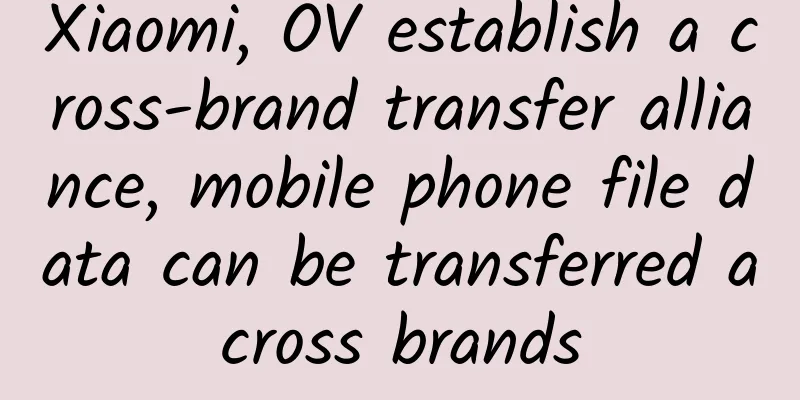Xiaomi, OV establish a cross-brand transfer alliance, mobile phone file data can be transferred across brands

|
On August 19, the three major mobile phone manufacturers Xiaomi, OPPO, and vivo jointly established the Mutual Transfer Alliance with the "Mobile Point-to-Point Fast Transfer Protocol" as the transmission standard to bring users a better file transfer experience. This move will break through the platform barriers for transferring files and data between smartphones - almost all mobile phone manufacturers only support transferring files and data within their brands. According to the official introduction, after the establishment of the Inter-Transfer Alliance, Xiaomi, OPPO and vivo can realize cross-brand mobile phone file data transfer with one click, without the need to install third-party software; after intercommunication, the transferred files support multiple formats such as pictures, documents, videos, music, etc.; moreover, the pairing speed is fast, the transmission process is stable, no traffic is required, and the transmission speed can reach 20MB/s. Taking any manufacturer's mobile phone as an example, when you need to share files with mobile phone users of the other two manufacturers, you only need to enable the mutual transfer function in the drop-down menu, turn on the Wi-Fi and Bluetooth switches at the same time, then click Share in the edit bar, click the other user's avatar to send, and the recipient can confirm to receive. Currently, the alliance includes Xiaomi, OPPO, and vivo, and the official said that more manufacturers are expected to join. Lei Jun, founder and chairman of Xiaomi, and Lu Weibing, vice president of Xiaomi and general manager of Redmi, also forwarded the Weibo and said, "We welcome other friendly companies to join." It is reported that the mutual transfer function will start public testing in the near future and is expected to be launched at the end of August. It is worth noting that according to a report on the Chinese smartphone market in the second quarter of 2019 released by market research firm Canalys, China's smartphone shipments in Q2 totaled 97.6 million units, down 6% from 103.6 million units in the same period last year; among them, except for Huawei, shipments of other mobile phone manufacturers including OPPO, vivo, and Xiaomi all declined - Huawei's shipments increased by 31% year-on-year, while Xiaomi and OV's year-on-year declines exceeded 10%. In the view of Leiphone.com, the alliance formed between Xiaomi, OPPO and vivo will help them to open up cooperation and build an ecosystem together; from another perspective, the three companies' ability to transfer files between mobile phones will also help them improve their competitiveness in the fiercely competitive Chinese smartphone market. This article is reproduced from Leiphone.com. If you need to reprint it, please go to Leiphone.com official website to apply for authorization. |
>>: Please enjoy a comprehensive Android obfuscation feast
Recommend
Five years of Steve Jobs imitation show: Chinese mobile phones are stuck in an acting dilemma
[[142117]] Life depends on acting. Since August 1...
With wolves in front and tigers behind, is there still hope for Sony mobile phones?
The current smartphone market structure is basica...
Mycoplasma outbreak in China? Maybe it's just an illusion
The incidence of false negative and false positiv...
2019 Fliggy 3rd Anniversary Event Planning and Promotion Plan!
This article mainly wants to share with you my pe...
How to choose H5 multi-channel App promotion?
Nowadays, there are more and more channels for Ap...
Apple's stock price plummeted 6% and has embarked on a bear market
On Friday, Apple's stock price plummeted agai...
It can grow a new head even if it's missing! Why is the "Axolotl" so amazing?
If you love to visit flower and bird markets, you...
Technology Outlook 2025: The era of AI autonomy is coming, and trust is the key cornerstone
The new era of AI autonomy and the urgency of ent...
How to build an online operation and promotion system?
How to build a comprehensive online operation and...
Experts warn: GPS is taking away our sense of direction
According to the British Daily Mail, experts say ...
Why are there mirrors in elevators? 99% of people can't figure it out!
Source: Dr. Curious...
Look! There are a group of prehistoric monsters "sealed" in the rocks!
The fantastic creatures that are difficult to dis...
What is Computer Graphics?
1. What is computer graphics? What is Computer Gr...
The high-definition schematic diagram of the Chinese space station is here! Common terminology knowledge post for manned space flight, it is recommended to collect
With the safe return of the three astronauts Zhai...
IHS: Demand for new display materials surges in the second half of 2015
According to IHS research, as LG Display increase...









